Page 5 of 308
Downloaded from www.Manualslib.com manuals search engine I
’ , .: 1 .>
w The dynumic William C “Billy ’’ Durant
shlfted gearsfram
muking carriages to
making cars,
forming half the team that
gave birth to Chevrolet.
Louis Chevrolet, the other
half of the team, at
the wheel of his experimental “Classic Six,”
which enteredproduction in 1912. That year
2999 vehicles were produced.
Page 21 of 308
Downloaded from www.Manualslib.com manuals search engine u ..
Why Safety Belts Work
When you ride in or on anything, you
go as fast as it goes.
1. For example, if the bike is going
10 mph (16 km/h), so is the child.
I
2. When the bike hits the block, it
stops.
But the child keeps going!
3. Take the simplest “car.” Suppose
it’s just a seat on wheels.
19 ..I
Page 55 of 308
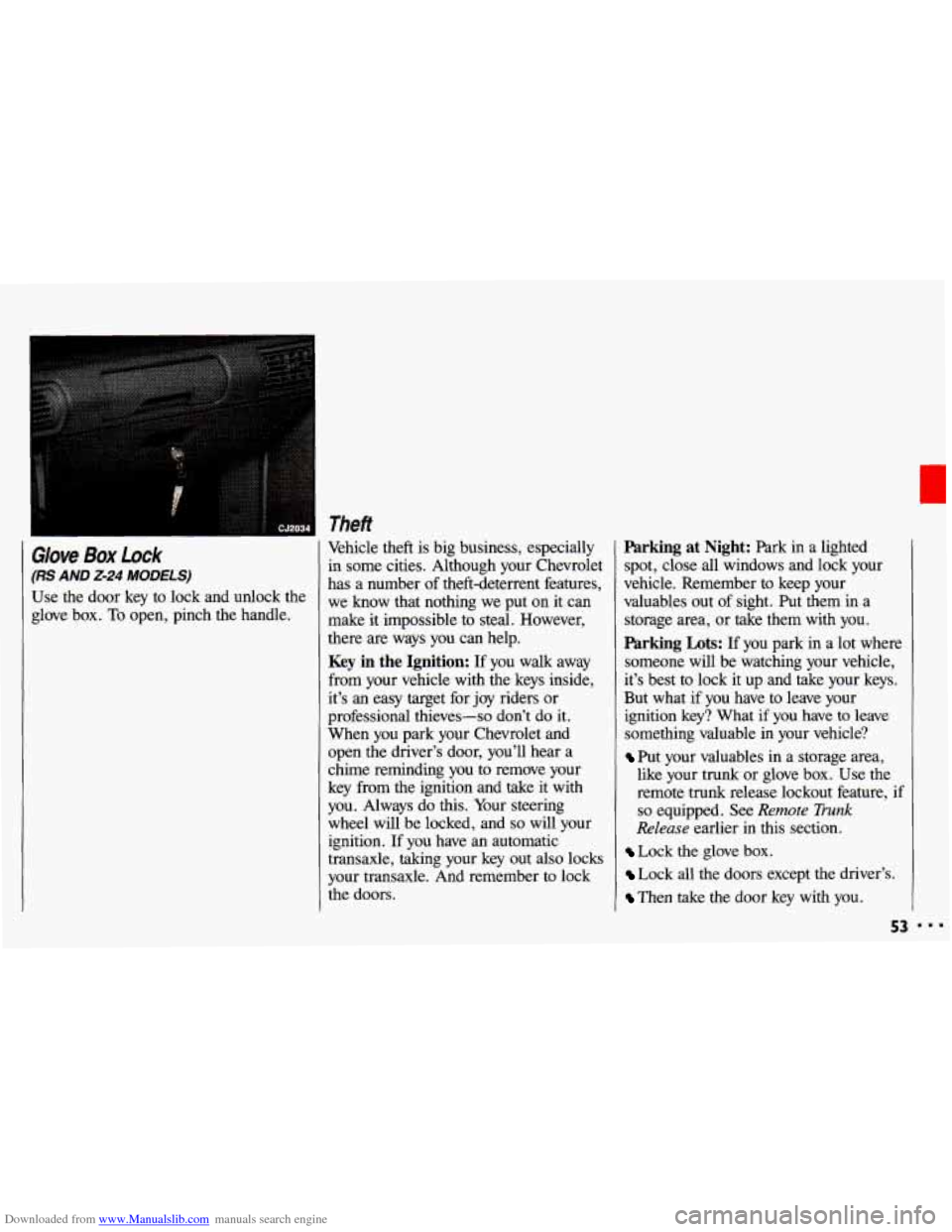
Downloaded from www.Manualslib.com manuals search engine Theft
Glove Box Lock
(RS AND 2-24 MODELS)
Use the door key to lock and unlock the
glove box.
To open, pinch the handle, Vehicle theft
is big business, especially
in some cities. Although your Chevrolet
has a number of theft-deterrent features,
we know that nothing we put on it can
make it impossible to steal. However,
there are ways you can help.
Key in the Ignition: If you walk away
from your vehicle with the keys inside,
it’s an easy target for joy riders or
professional thieves-so don’t do it.
When you park your Chevrolet and
open the driver’s door, you’ll hear a
chime reminding you
to remove your
key from the ignition and take
it with
you. Always do this. Your steering
wheel will be locked, and
so will your
ignition. If you have an automatic
transaxle, taking your key out also locks
your transaxle. And remember to lock
the doors.
Parking at Night: Park in a lighted
spot, close all windows and lock your
vehicle. Remember to keep your
valuables out of sight. Put them in a
storage area, or take them with you.
Parking Lots: If you park in a lot where
someone will be watching your vehicle,
it’s best
to lock it up and take your keys.
But what if you have to leave your
ignition key? What if you have to leave
something valuable in your vehicle?
Put your valuables in a storage area,
like your trunk or glove box. Use the
remote trunk release lockout feature,
if
so equipped. See Remote Trunk
Release earlier in this section.
Lock the glove box.
Lock all the doors except the driver’s.
Then take the door key with you.
53
Page 57 of 308
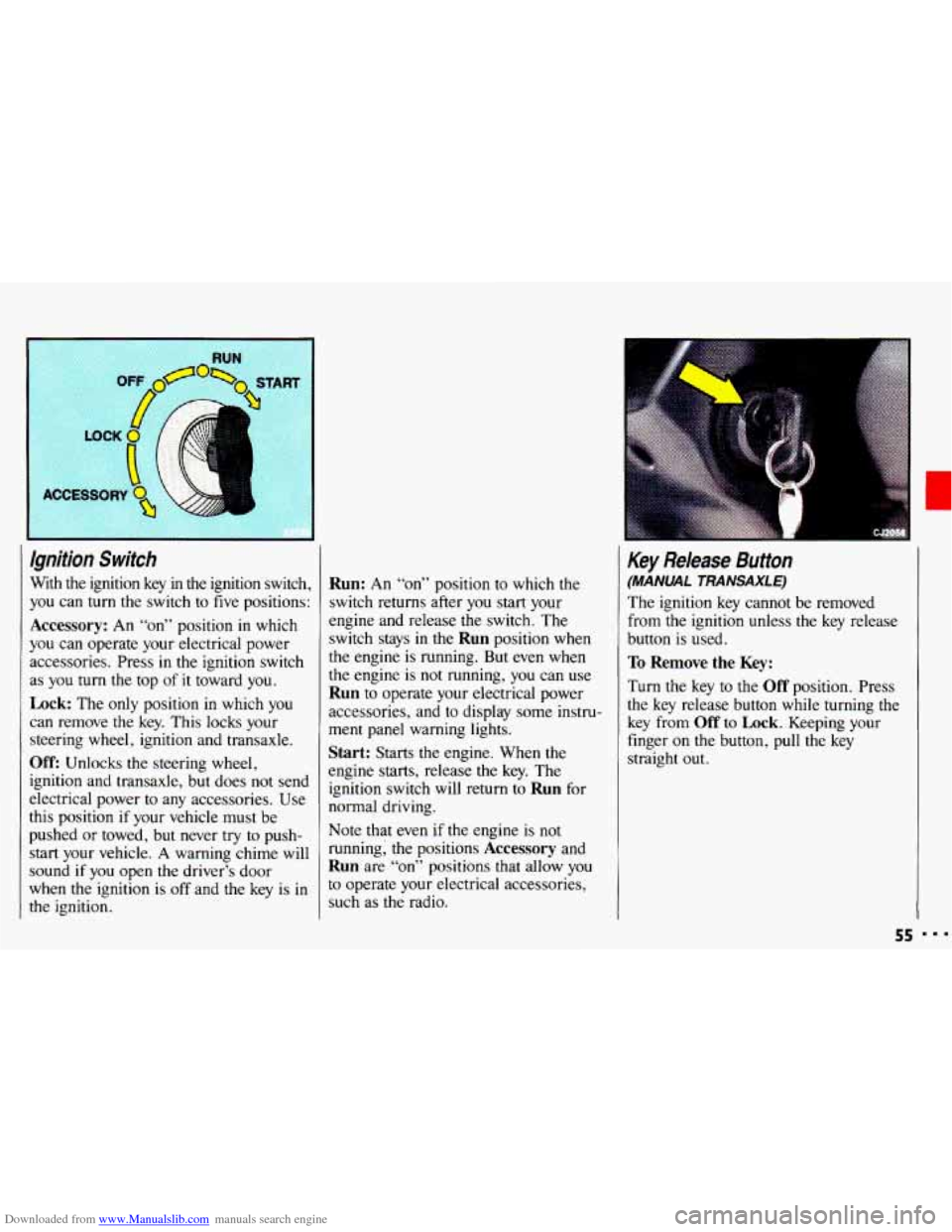
Downloaded from www.Manualslib.com manuals search engine Ignition Switch
With the ignition key in the ignition switch,
you can
turn the switch to five positions:
Accessory: An “on” position in which
you can operate your electrical power
accessories. Press in the ignition switch
as
you turn the top of it toward you.
Lock: The only position in which you
can remove the key. This locks your
steering wheel, ignition and transaxle.
Off: Unlocks the steering wheel,
ignition and transaxle, but does not send
electrical power
to any accessories. Use
this position
if your vehicle must be
pushed
or towed, but never try to push-
start your vehicle.
A warning chime will
sound
if you open the driver’s door
when the ignition is
off and the key is in
the ignition.
Run: An “on” position to which the
switch returns after
you start your
engine and release the switch. The
switch stays in
the Run position when
the engine is running. But even when
the engine is not running, you can use
Run to operate your electrical power
accessories, and to display some instru-
ment panel warning lights.
Start: Starts the engine. When the
engine starts, release the key. The
ignition switch will return to
Run for
normal driving.
Note that even
if the engine is not
running; the positions
Accessory and
Run are “on” positions that allow you
to operate your electrical accessories,
such as the radio.
Key Release Button
(MANUAL TRANSAXLE)
The ignition key cannot be removed
from
the ignition unless the key release
button is used.
To Remove the Key:
Turn the key to the Off position. Press
the key release button while turning the
key from
Off to Lock. Keeping your
finger
on the button, pull the key
straight
out.
55
Page 58 of 308
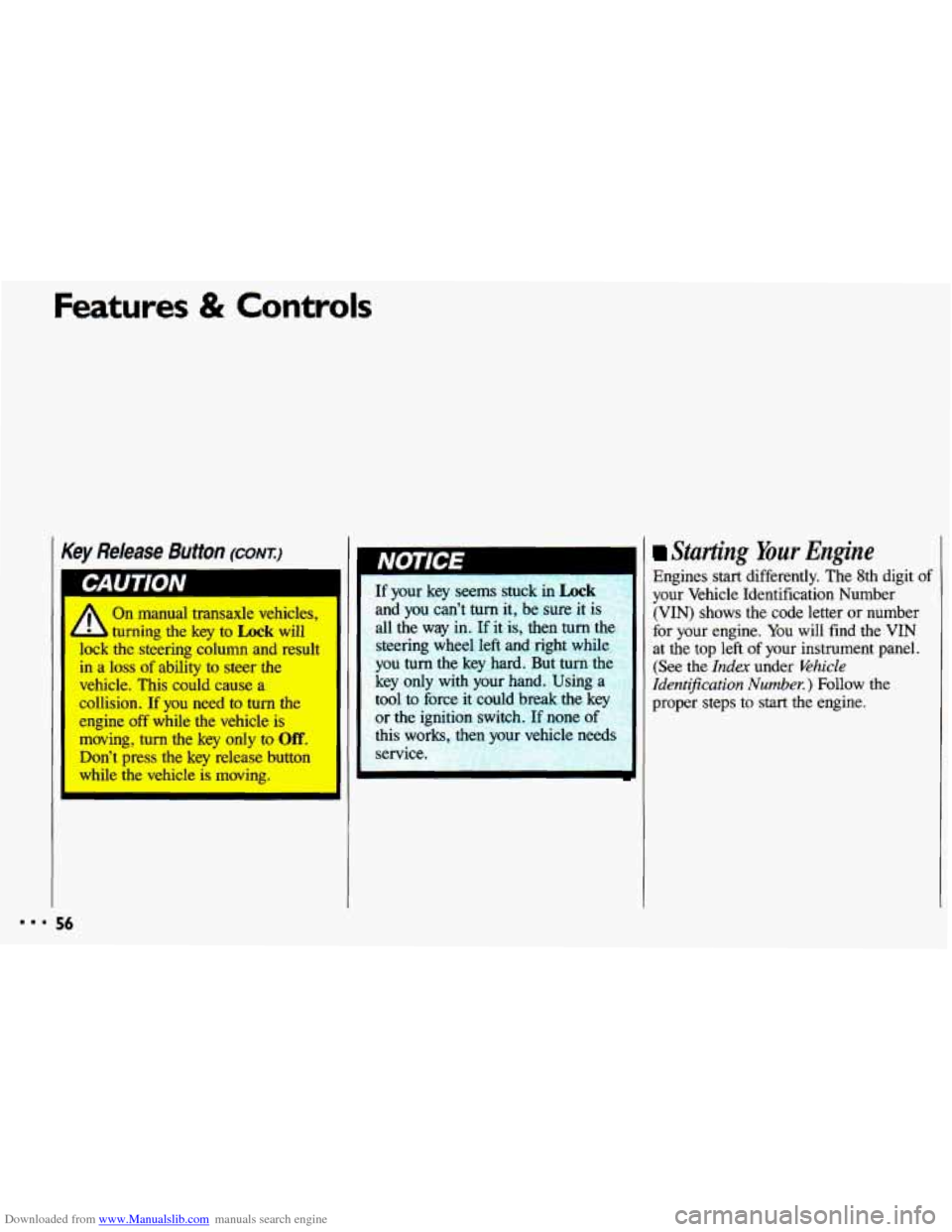
Downloaded from www.Manualslib.com manuals search engine Features & Contr
Key Release Button (CONT.)
On manual transaxle vehicles,
- udng the key ta Lock will
lock the shMg column and result
in a loss of ability to steer the
vehicle. This could cause a
collision, If you need to tum the
engine off while the vehicle is
moving, turn the key only to Off.
Don’t press the key release button
while the vehicle is mcwing.
If your key seems stuck in Lock
and you can’t turn it, be sure it is
all the way in.
If it is, then turn tl
steering wheel left and right while
you
turn the key hard. But turn the
key only with your hand. Using a
tool to force it could break the
key
or the ignition switch. If none
this works,
t 1 yc vehicle needs
service.
Starting Your Engine
Engines start differently. The 8th digit of
your Vehicle Identification Number
(VIN) shows the code letter or number
for your engine. You will find the
VIN
at the top left of your instrument panel.
(See the Index under &hick
Ident@cation Number. ) Follow the
proper steps to start the engine.
56
Page 62 of 308
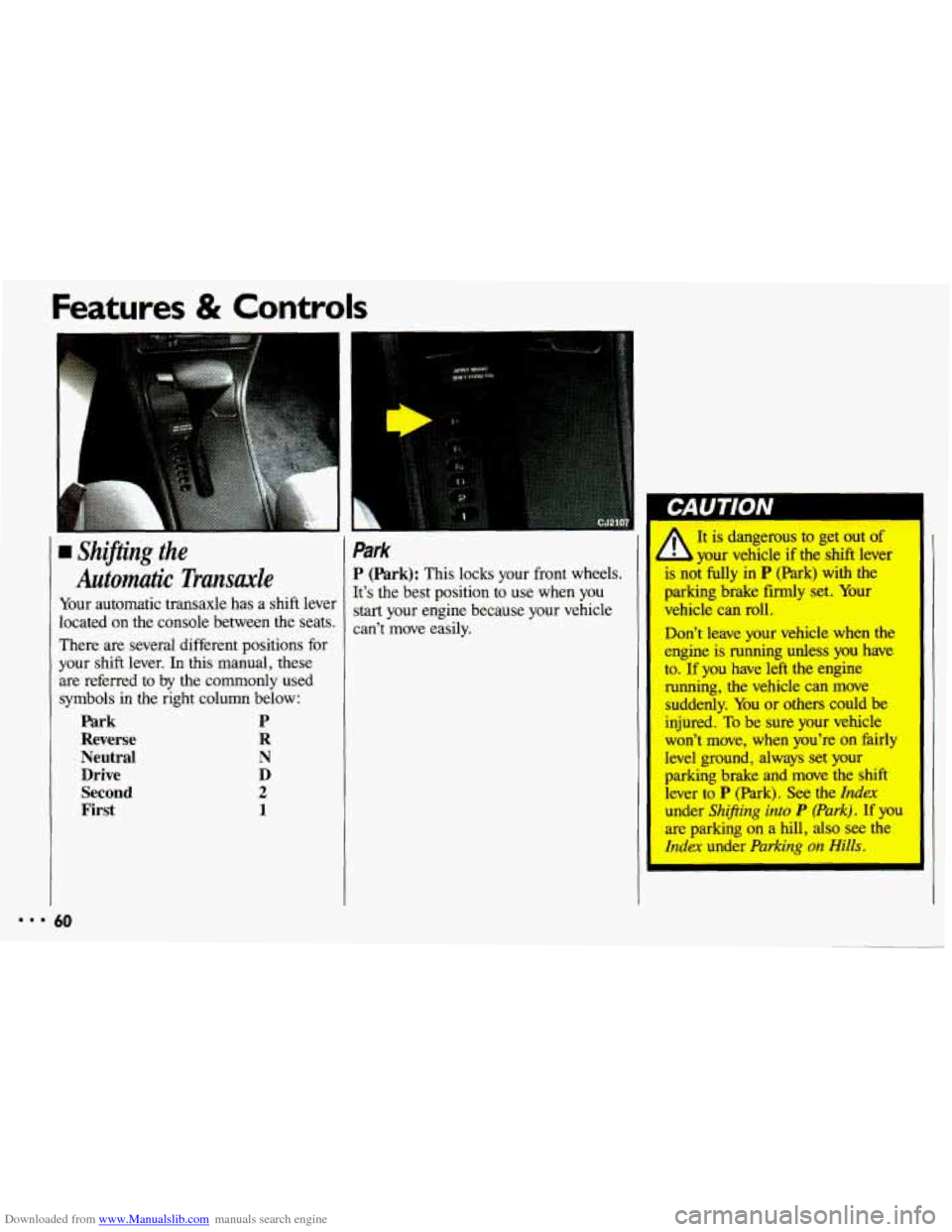
Downloaded from www.Manualslib.com manuals search engine Features & Controls
rn Shifting the
Automatic Transaxle
Your automatic transaxle has a shift lever
located
on the console between the seats.
There are several different positions for
your shift lever. In this manual, these
are referred to by the commonly used
symbols in
the right column below:
Park P
Reverse R
Neutral
N
Drive D
Second
2
First 1
Park
P (Park): This locks your front wheels.
It’s the best position to use when you
start your engine because your vehicle
can’t move easily.
I It is dangerous to get out of
your vehicle if the shift lever
is noi fully in
P (Park) with the
parking brake firmly set. Your
vehicle can roll.
Don’t leave your vehicle when the
engine is running unless
you have
to.
If you have left the engine
running, the vehicle can move
suddenly. You or others could be
injured.
To be sure your vehicle
won’t move, when you’re on fairly
level ground, always set your
parking brake and move the shift
lever to
P (Park). See the Index
under Shifting into P (Park). If you
are parking on a hill, also see the
Index under Parking on Hills.
Page 63 of 308

Downloaded from www.Manualslib.com manuals search engine Ensure the shift lever is fully in P (Park)
range before starting the engine. Your
Chevrolet has a brake-transaxle shift
interlock. You have to fully
apply your
regular brakes
before you can shift fiom
P (Park) when the ignition key is in the
Run position. If you cannot shift out of
P (Park), ease pressure on the shift
lever-push the shift lever
all the way
into
P (Park) and also release the shift
lever button as you maintain brake
application. Then move the shift lever
into
the gear you wish. See the Index
under Shifting Out of P (Park),
U
Reverse
R (Reverse): Use this gear to back up.
Shifting to
R (Reverse) while your
vehicle
is moving forward could
damage your transaxle. Shift
to R
only after your vehicle has
Stopped-
Neutmi
N (Neutral): In this position, your
engine doesn’t connect with the wheels.
To restart when you’re already moving,
use
N (Neutral) only. Also, use N when
your vehicle
is being towed.
To rock your vehicle back and forth to
get out of snow, ice or sand without
damaging your transaxle, see the
Index
under If You ’re Stuck: In Sand, Mud,
Ice or Snow.
61
Page 65 of 308
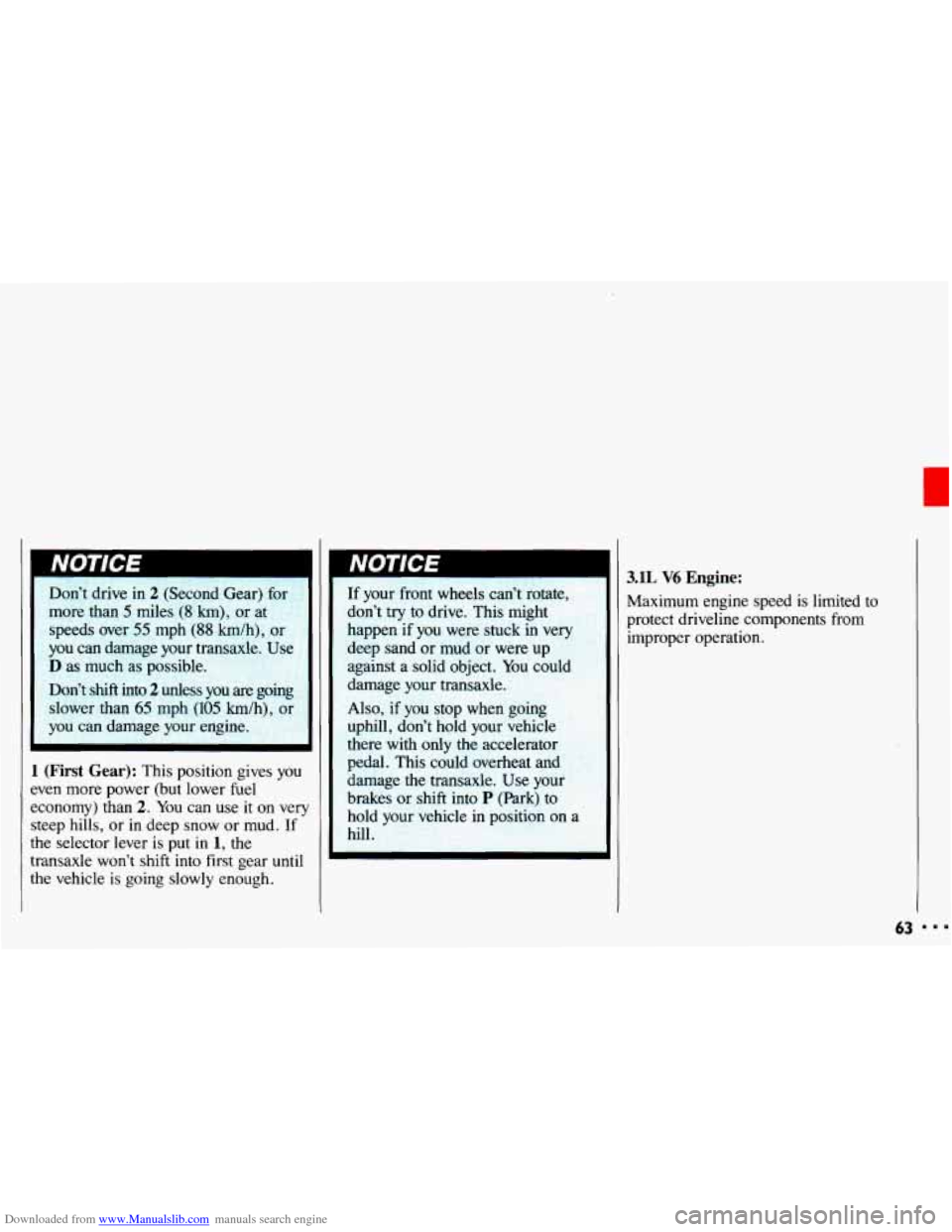
Downloaded from www.Manualslib.com manuals search engine Don’t drive in 2 (Second Gear) fo
more than 5 miles (8 km), or at
speeds over
55 mph (88 km/h), or
you can damage your transaxle. U!
D as much as possible.
Don’t
shift into 2 unless you are going
slower than
65 mph (105 km/h),
you can damage your engine.
r I
1 (First Gear): This position gives you
even more power (but lower fuel II
If your front wheels can’t rotate,
don’t try to drive. This might
happen if
you were stuck in very
deep sand or mud or were up
against a solid object.
aula
damage your transal-’
Also, if you stop when going
uphill, don’t hold your vehicle
there with only
the accelerator
-
pedal. This cduld overheat and
damage the transaxle.
Use your
brakes or shift into
P (Park) to
hold lr vehicle
in position on a
hill.
economy)
than 2. You can use it crh very
steep hills, or in deep snow or mud. If
the selector lever is put in 1, the
transaxle won’t shift
into first gear until
the vehicle is going slowly enough.
3.lL V6 Engine:
Maximum engine speed is limited to
protect driveline components from
improper operation.